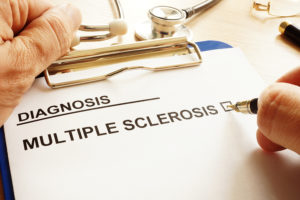Multiple Sclerosis (MS) is a progressive inflammatory disease of the central nervous system whereby the body’s immune system attacks nerves and protective nerve fibers (myelin sheath) in the brain and spinal cord. Over time, nerves become damaged and inflamed, which results in impaired signaling between the brain, the spinal cord, and the rest of the body. This process brings about an array of symptoms which can range from mild to severe. Understanding what the signs and symptoms are is important, as therapy for this condition can be sought out with a medical professional to help manage the disease. Although there is currently no cure, there are treatments available which can help to alleviate the symptoms of the disease. So, what are warning signs of MS, and when do they first begin to affect those who develop the disease?
Most people who develop MS first have symptoms in their 20’s and 30’s, although the onset of symptoms can be at any age (Leonard, 2018). Common initial signs or indications of the illness include:
- Vision changes such as blurred vision, double vision, vision loss, and other abnormalities with eye function.
- Weakness and fatigue, which often affects the legs first before spreading to other parts of the body. This may come and go, or it may last for weeks at a time (Leonard, 2018).
- Tingling and numbness in the arms, fingers, face, legs and other parts of the body is often one of the first symptoms in those who are eventually diagnosed with MS. These symptoms are often mild at first but become more severe over time (National Multiple Sclerosis Society).
- Dizziness, lightheadedness, nausea and loss of balance. Vertigo is less common but may also occur.
- Bladder problems which can result in urinary incontinence, urinary frequency, difficulty urinating, and other issues related to bladder dysfunction.
- Changes in cognition, which affect approximately 50% of those with MS. Cognitive changes may affect memory, concentration, attention span, problem-solving skills, and other areas of cognition (Leonard, 2018).
Some of the less common symptoms of MS include:
- Headaches
- Tremors
- Breathing difficulties
- Seizures
It is also important to be aware of the risk factors of MS. Although the disease is rare, with the average person having an approximate 0.1% chance of developing it in his or her lifetime, there is up to a 5% chance of developing it if there is a family history (Leonard, 2018). Additionally, MS affects approximately twice as many women as men. Smokers are also at a greater risk of having the disease too.
Knowledge of the signs, symptoms, and risk factors of multiple sclerosis can go a long way in seeking out a timely diagnosis. The earlier a diagnosis and treatment are made, the slower the disease may progress. Symptoms can also become more manageable with timely treatments.
Interested in learning more about Multiple Sclerosis research? The Premiere Research Institute in West Palm Beach regularly conducts clinical research studies in the field of MS. To find out more about these studies please click here or sign up for their newsletter to keep informed about the newest treatments, articles, and research that are being conducted in the field of MS.
References:
Leonard, J. (2018, September 20). What are the early signs of MS? Retrieved October 17, 2018, from https://www.medicalnewstoday.com/articles/323130.php
MS Symptoms. (n.d.). National Multiple Sclerosis Society. Retrieved October 17, 2018, from https://www.nationalmssociety.org/Symptoms-Diagnosis/MS-Symptoms
